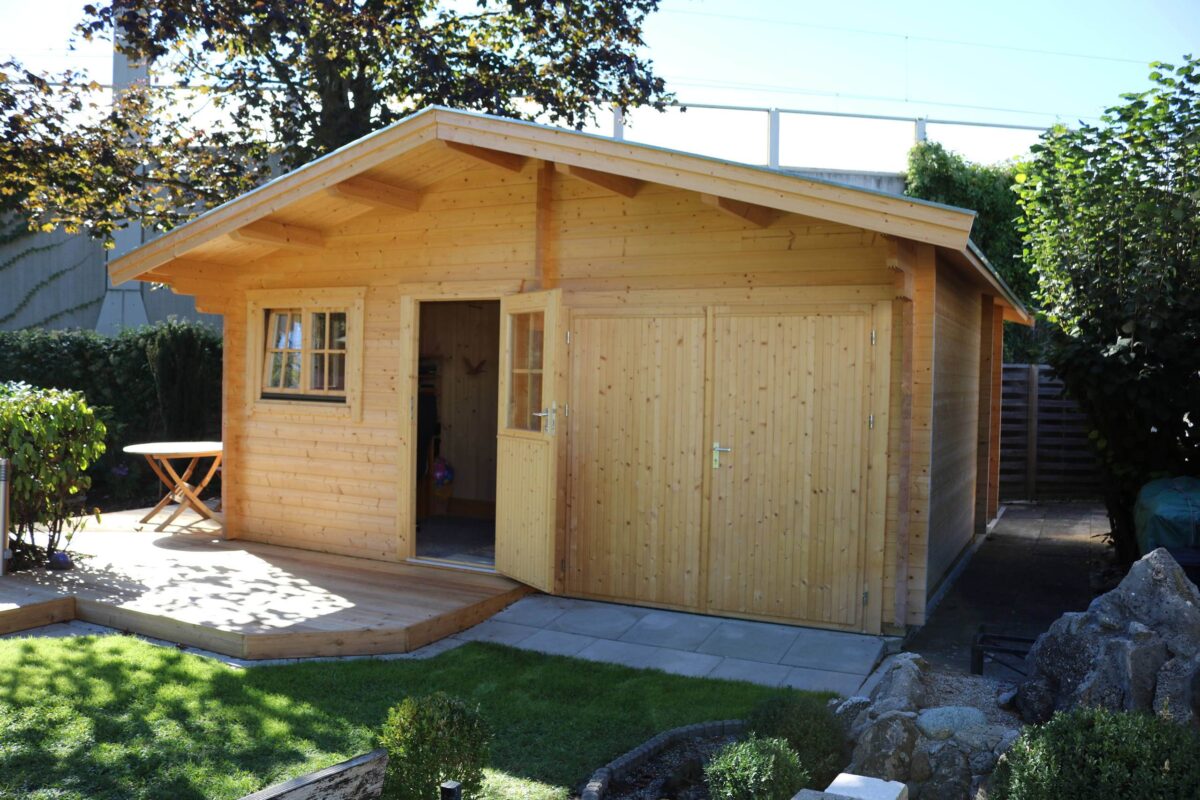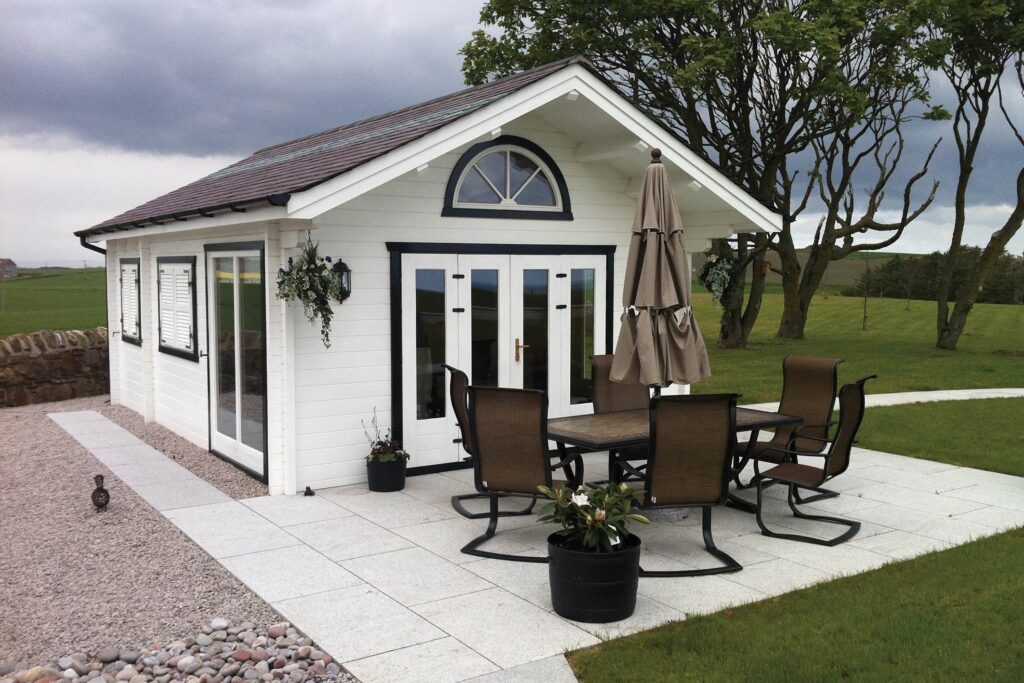

Common types of Garden Room foundations
- 1. What to consider when choosing and preparing a foundation for a Garden Room?
- 1.1. Fundation types for garden room
- 1.2. Garden room size, weight and building regulations
- 2. Base for Garden Room without concrete
- 2.1. Paving slabs as a foundation for the Garden Room
- 2.2. Poinf Foundation
- 2.3. Lattice Foundation
- 3. Ground screws for Garden Rooms
- 3.1. When should I use a screw foundation for my garden room?
- 4. How do I prepare a concrete base for a Garden Room?
- 4.1. Plinths foundations
- 5. Do I need to build a base for my garden room?
- 6. What are advantages of a foundation for a Garden Room?
- 7. Costs of the Foundation
Building a garden room requires careful planning and preparation, especially when it comes to creating the foundation. A stable and well-thought-out foundation is crucial to ensure the longevity and stability of the garden house. This guide will take you step by step through the process of preparing the foundation for your garden room. From selecting the right location, preparing the ground, to choosing the appropriate materials, we provide all the necessary information and practical tips to create a solid foundation that will securely support your garden room for many years. Let’s lay the groundwork for your new garden project together!
What to consider when choosing and preparing a foundation for a Garden Room?
When choosing and preparing a foundation for a garden room, several important factors must be considered. First, you need to determine which type of foundation is best suited for your garden house.
Fundation types for garden room
We can list common foundation types like: concrete foundations, pile foundations, slab foundations and ground screw. Concrete foundations offer a particularly stable and durable base, while pile foundations are suitable for lighter constructions and have the advantage of being less labor-intensive in preparation. Slab foundations provide a good alternative when a flat and solid surface is needed.
Garden room size, weight and building regulations
Another crucial aspect is the relevant building regulations. The size and weight of the garden house play a decisive role. Smaller, lightweight garden sheds with a post and beam construction can often be built with post anchors. However, for larger garden houses, especially those made of log cabins, a suitable foundation is required. Depending on the size and type of the chosen model, different foundation types are possible, which vary both in the materials used and the required amount of work.

Base for Garden Room without concrete
In addition to concrete foundations, there are also foundational options without concrete that can offer stable and reliable solutions. These variants are often quicker and easier to install and are ideal for smaller garden houses and temporary structures. They also offer the advantage of being easily removable or adjustable if needed.
Paving slabs as a foundation for the Garden Room
A foundation without concrete offers several advantages: it is more environmentally friendly, quicker to build, and more cost-effective. It also allows for easy dismantling if the garden room needs to be removed at some point. A commonly used concrete-free foundation consists of paving slabs. First, the area is marked out, and the topsoil is removed to a depth of about 20 to 30 cm. A layer of coarse gravel or crushed stone is then filled into the pit and compacted. On top of this layer, a thinner layer of sand is smoothed out. The paving slabs are then laid on the sand, ensuring they are even and stable. A spirit level helps to ensure a flat surface. Finally, the joints between the slabs are filled with sand and swept multiple times until all joints are filled.
Poinf Foundation
Another option is the screw foundation. Here, a free area in the garden is chosen, and the soil is checked for its suitability. A drawing of the foundation frame is created to take into account the exact dimensions of the garden room. Ground screws are installed at the marked spots and screwed to the foundation frame. The frame is then placed on the ground screws, and additional smaller ground screws are installed to increase stability. Finally, all ground screws are firmly screwed to the foundation frame.
Lattice Foundation
A lattice foundation offers an environmentally friendly, cost-effective, and flexible alternative to concrete foundations for garden houses. It consists of sturdy wooden slats laid in a grid pattern that can adapt to different soil types, reducing preparation time and costs. Wood, as a renewable resource, causes fewer CO₂ emissions than concrete and can be easily dismantled and reused or disposed of environmentally at the end of its life. The simple and quick installation of a lattice foundation requires less technical expertise and provides excellent moisture control through improved ventilation, preventing mold growth and wood decay.
Ground screws for Garden Rooms
Screw foundations are a modern and increasingly popular solution for building foundations. They offer an efficient and environmentally friendly alternative to traditional concrete foundations. This method saves time and reduces construction costs, as excavation is minimal and environmental impact is lower. Screw foundations provide high load-bearing capacity and can be installed in various soil types, including difficult terrain conditions. Adjustments or extensions can also be easily made later. They are used for buildings, carports, fences, advertising structures, and solar installations, as well as temporary buildings such as construction site offices.
When should I use a screw foundation for my garden room?
A screw foundation is ideal for your garden room if you’re dealing with uneven terrain, soft soil, or areas prone to frost heave. This type of foundation offers a quick installation process that does not require extensive excavation, making it an eco-friendly option that minimizes landscape disruption. Screw foundations are also perfect for projects where time constraints are a concern, as they can be installed in a matter of hours and are immediately load-bearing. Additionally, if you anticipate the need for future adjustments or relocations of your garden room, screw foundations provide flexibility, as they can be easily unscrewed and repositioned. This makes them a superb choice for temporary structures or when preserving the natural setting is a priority.
How do I prepare a concrete base for a Garden Room?
Preparing a concrete foundation requires precise steps. First, the area must be thoroughly prepared: remove vegetation, debris, and topsoil, ensuring the subsoil is level and compacted. Next is the excavation: dig out the area according to the plan specifications. The depth and width of the excavation depend on the size of the foundation and should be done precisely. Then, install the formwork: place and secure the wooden or metal forms around the excavation to define the shape of the foundation. In the next step, lay the reinforcement by placing steel reinforcement or wire mesh within the formwork. This strengthens the concrete and prevents cracking. The concrete pour follows: mix the concrete and pour it evenly into the formwork, avoiding air pockets. Once the concrete is poured, level and smooth the surface using a screed board and trowel to achieve a uniform finish. The final step is curing the concrete: keep it moist and covered for at least 7 days to maximize strength. After curing, carefully remove the formwork and inspect the foundation for defects. By following these steps, you will create a stable and durable concrete foundation that provides a solid base for your construction project.
Plinths foundations
Plinths are another type of concrete foundation commonly used for garden rooms. Typically made from reinforced concrete, a plinth helps to distribute the weight of the garden room over a broader area. One of the main advantages of plinths is their straightforward installation process. Unlike concrete slabs, plinths do not require any setting time. They are highly effective at withstanding significant pressure and movement, thus preventing any structural damage to your garden room. Additionally, plinths can be easily removed from the ground without leaving any residue, making them an environmentally friendly choice. However, plinths are best suited for smaller projects.
Do I need to build a base for my garden room?
Building a base for your garden room is essential. Here are the key reasons why:
- Stability:
- A solid base for garden room ensures that your garden room remains stable and level, preventing uneven settling or shifting over time.
- Durability:
- A proper foundation protects the structure from ground moisture, which can lead to wood rot, mold, and structural damage.
- Insulation:
- Elevating the garden room off the ground helps with insulation, making the interior more comfortable year-round.
- Compliance:
- Many local building codes require a foundation for any permanent or semi-permanent structure to ensure safety and durability.
- Resale Value:
- A well-built garden room with a solid foundation can increase the value of your property.
Investing in a proper base not only extends the lifespan of your garden room but also ensures a safe and stable environment for your enjoyment.
What are advantages of a foundation for a Garden Room?
A solid foundation for a garden room is like the secure base of a house – it provides essential protection and support. Firstly, it gives the garden house unwavering stability. By ensuring even load distribution, the foundation protects against unsightly settlements or deformations that could otherwise diminish the charm and functionality of the garden room. Secondly, it offers a protective shield against moisture. The foundation acts as a barrier, keeping moisture from the ground away and thus protecting the garden room from mold and wood damage. This additional protection not only keeps the garden house in top condition for longer but also provides a pleasant and healthy indoor climate for your time in the garden.
Costs of the Foundation
The costs for a garden room foundation can vary greatly depending on the material and size. Concrete foundations typically cost between 50 and 100 euros per square meter. For a foundation made of precast concrete slabs, prices are around 40 to 80 euros per square meter. Screw foundations, which can be quickly installed, cost about 60 to 120 euros per piece, depending on the size and number of screws. The exact costs depend on the specific project requirements and local conditions. In summary, a foundation for your garden room is much more than just a structural base – it is the guarantor of stability and protection. It protects the garden house from moisture and ensures a long lifespan. Even though costs vary depending on the material, investing in a solid foundation is a decision that pays off in the long run, turning your garden house into a safe and comfortable retreat.






